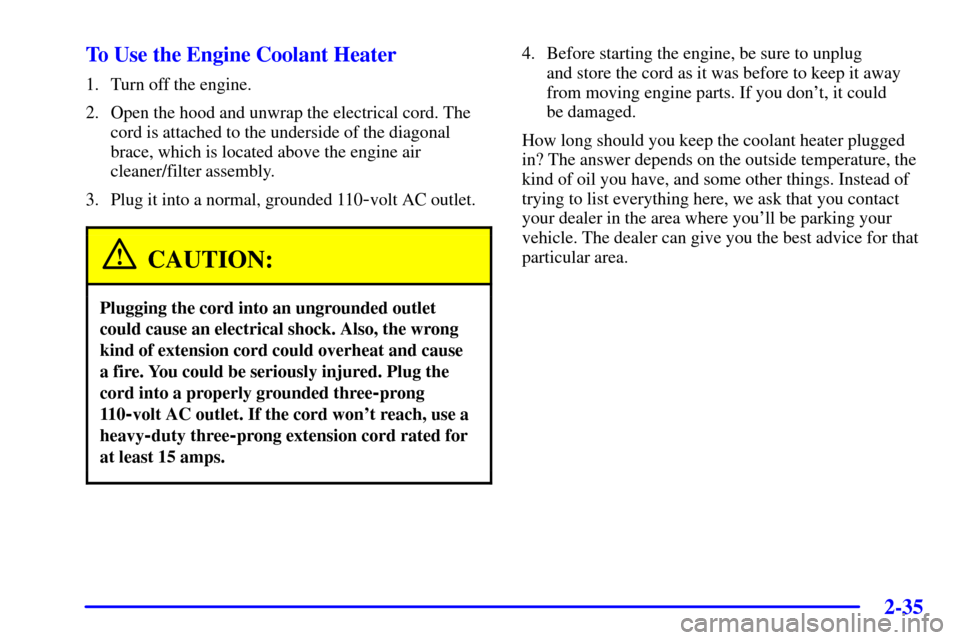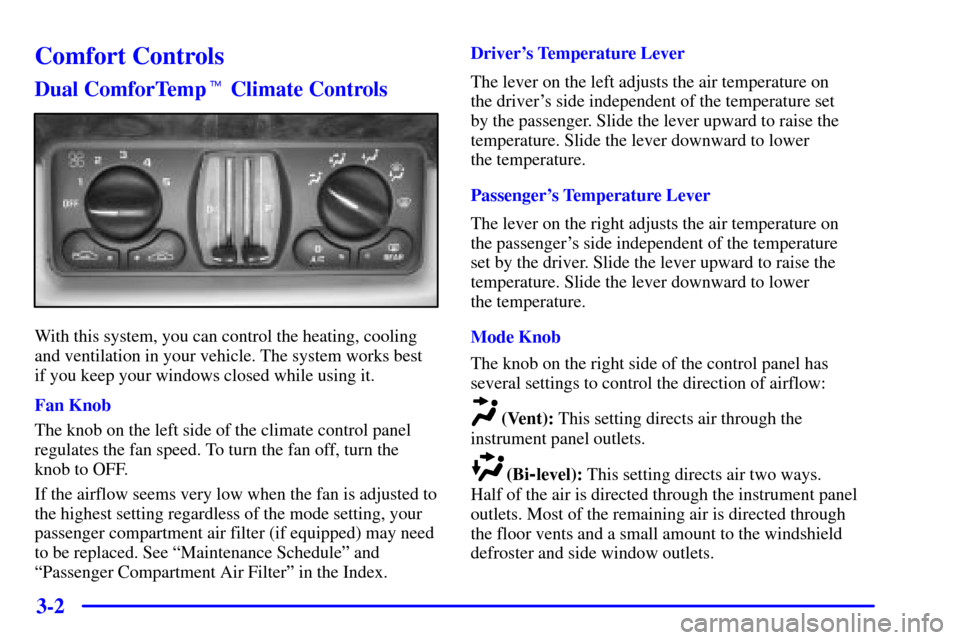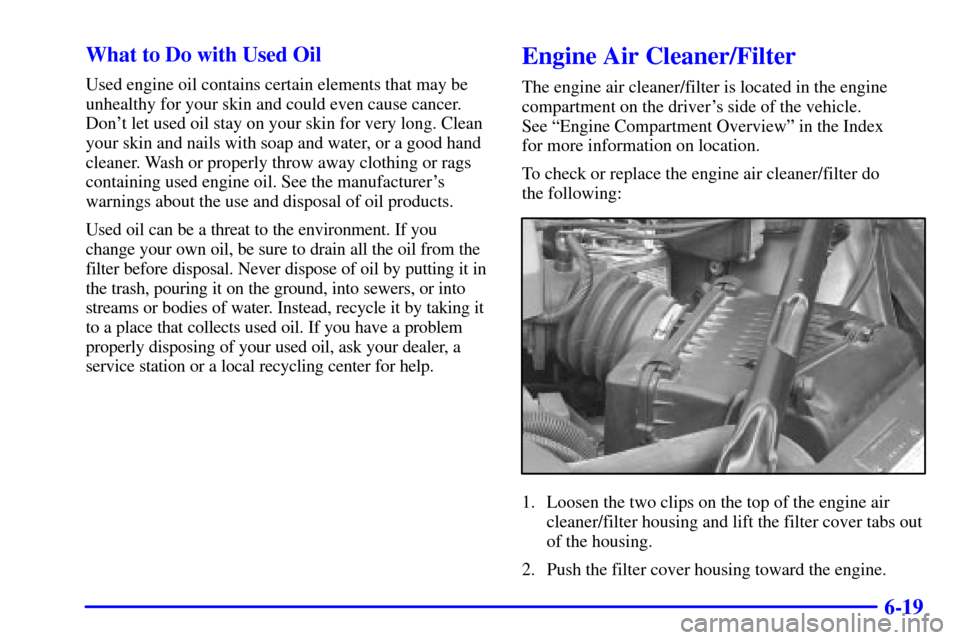Page 101 of 397

2-35
To Use the Engine Coolant Heater
1. Turn off the engine.
2. Open the hood and unwrap the electrical cord. The
cord is attached to the underside of the diagonal
brace, which is located above the engine air
cleaner/filter assembly.
3. Plug it into a normal, grounded 110
-volt AC outlet.
CAUTION:
Plugging the cord into an ungrounded outlet
could cause an electrical shock. Also, the wrong
kind of extension cord could overheat and cause
a fire. You could be seriously injured. Plug the
cord into a properly grounded three
-prong
11 0
-volt AC outlet. If the cord won't reach, use a
heavy
-duty three-prong extension cord rated for
at least 15 amps.
4. Before starting the engine, be sure to unplug
and store the cord as it was before to keep it away
from moving engine parts. If you don't, it could
be damaged.
How long should you keep the coolant heater plugged
in? The answer depends on the outside temperature, the
kind of oil you have, and some other things. Instead of
trying to list everything here, we ask that you contact
your dealer in the area where you'll be parking your
vehicle. The dealer can give you the best advice for that
particular area.
Page 174 of 397

3-2
Comfort Controls
Dual ComforTemp� Climate Controls
With this system, you can control the heating, cooling
and ventilation in your vehicle. The system works best
if you keep your windows closed while using it.
Fan Knob
The knob on the left side of the climate control panel
regulates the fan speed. To turn the fan off, turn the
knob to OFF.
If the airflow seems very low when the fan is adjusted to
the highest setting regardless of the mode setting, your
passenger compartment air filter (if equipped) may need
to be replaced. See ªMaintenance Scheduleº and
ªPassenger Compartment Air Filterº in the Index.Driver's Temperature Lever
The lever on the left adjusts the air temperature on
the driver's side independent of the temperature set
by the passenger. Slide the lever upward to raise the
temperature. Slide the lever downward to lower
the temperature.
Passenger's Temperature Lever
The lever on the right adjusts the air temperature on
the passenger's side independent of the temperature
set by the driver. Slide the lever upward to raise the
temperature. Slide the lever downward to lower
the temperature.
Mode Knob
The knob on the right side of the control panel has
several settings to control the direction of airflow:
(Vent): This setting directs air through the
instrument panel outlets.
(Bi-level): This setting directs air two ways.
Half of the air is directed through the instrument panel
outlets. Most of the remaining air is directed through
the floor vents and a small amount to the windshield
defroster and side window outlets.
Page 178 of 397

3-6 Ventilation System
Change the direction
of the airflow by
adjusting the vents.
Your vehicle's flow
-through ventilation system
supplies outside air into the vehicle when it is
moving. Outside air will also enter the vehicle when
the air conditioning compressor is running and the
outside air button is pressed
If the airflow seems very low when the fan is adjusted to
the highest setting, regardless of the mode setting, your
passenger compartment air filter (if equipped) may need
to be replaced. See ªMaintenance Scheduleº and
ªPassenger Compartment Air Filterº in the Index.Ventilation Tips
�Keep the hood and front air inlet free of ice, snow or
any other obstruction (such as leaves). The heater
and defroster will work far better, reducing the
chance of fogging the inside of your windows.
�When you enter a vehicle in cold weather, adjust the
mode knob to floor and the fan to the highest speed
for a few seconds before driving off. This helps clear
the intake ducts of snow and moisture and reduces
the chance of fogging the inside of your windows.
�Keep the air path under the front seats clear of
objects. This helps air to circulate throughout
your vehicle.
Page 290 of 397

6-
6-1
Section 6 Service and Appearance Care
Here you will find information about the care of your vehicle. This section begins with service and fuel information,
and then it shows how to check important fluid and lubricant levels. There is also technical information about your
vehicle, and a part devoted to its appearance care.
6
-2 Service
6
-3 Fuel
6
-5 Fuels in Foreign Countries
6
-6 Filling Your Tank
6
-8 Filling a Portable Fuel Container
6
-8 Checking Things Under the Hood
6
-12 Engine Oil
6
-19 Engine Air Cleaner/Filter
6
-20 Passenger Compartment Air Filter
(If Equipped)
6
-21 Automatic Transaxle Fluid
6
-24 Engine Coolant
6
-28 Radiator Pressure Cap
6
-28 Power Steering Fluid
6
-29 Windshield Washer Fluid
6
-31 Brakes6
-34 Battery
6
-35 Bulb Replacement
6
-40 Windshield Wiper Blade Replacement
6
-41 Tires
6
-51 Appearance Care
6
-51 Cleaning the Inside of Your Vehicle
6
-53 Care of Safety Belts
6
-55 Cleaning the Outside of Your Vehicle
6
-58 Finish Damage
6
-59 GM Vehicle Care/Appearance Materials
6
-60 Vehicle Identification Number (VIN)
6
-60 Service Parts Identification Label
6
-61 Electrical System
6
-68 Replacement Bulbs
6
-68 Capacities and Specifications
6
-70 Normal Maintenance Replacement Parts
Page 299 of 397
6-10 Engine Compartment Overview
When you open the hood on the 3400 V6 (Code E) engine, you'll see the following:
A. Windshield Washer
Fluid Reservoir
B. Lower Underhood Fuse Block
C. Upper Underhood Fuse Block
D. Radiator Pressure CapE. Engine Coolant RecoveryTank
F. Power Steering Fluid Reservoir
G. Engine Oil Fill Cap
H. Engine Oil DipstickI. Transaxle Fluid Dipstick
J. Brake Master
Cylinder Reservoir
K. Engine Air Cleaner/Filter
Page 300 of 397
6-11
When you open the hood on the 3800 V6 (Code K) engine, you'll see the following:
A. Windshield Washer
Fluid Reservoir
B. Lower Underhood Fuse Block
C. Upper Underhood Fuse Block
D. Radiator Pressure CapE. Engine Coolant RecoveryTank
F. Power Steering Fluid Reservoir
(low in engine compartment)
G. Engine Oil Dipstick
H. Engine Oil Fill CapI. Transaxle Fluid Dipstick
J. Brake Master
Cylinder Reservoir
K. Engine Air Cleaner/Filter
Page 308 of 397

6-19 What to Do with Used Oil
Used engine oil contains certain elements that may be
unhealthy for your skin and could even cause cancer.
Don't let used oil stay on your skin for very long. Clean
your skin and nails with soap and water, or a good hand
cleaner. Wash or properly throw away clothing or rags
containing used engine oil. See the manufacturer's
warnings about the use and disposal of oil products.
Used oil can be a threat to the environment. If you
change your own oil, be sure to drain all the oil from the
filter before disposal. Never dispose of oil by putting it in
the trash, pouring it on the ground, into sewers, or into
streams or bodies of water. Instead, recycle it by taking it
to a place that collects used oil. If you have a problem
properly disposing of your used oil, ask your dealer, a
service station or a local recycling center for help.
Engine Air Cleaner/Filter
The engine air cleaner/filter is located in the engine
compartment on the driver's side of the vehicle.
See ªEngine Compartment Overviewº in the Index
for more information on location.
To check or replace the engine air cleaner/filter do
the following:
1. Loosen the two clips on the top of the engine air
cleaner/filter housing and lift the filter cover tabs out
of the housing.
2. Push the filter cover housing toward the engine.
Page 309 of 397

6-20
3. Pull out the filter.
4. Check or install a new engine air cleaner/filter.
See ªNormal Maintenance Replacement Partsº in
the Index.
5. To reinstall the cover, position the tabs through the
slots on the housing. A notch on the sides of the
filter cover will indicate the correct engagement.
Reinstall the two clips on the top of the housing
when you are finished.
Refer to the Maintenance Schedule to determine when to
replace the air filter.
See ªScheduled Maintenance Servicesº in the Index.
CAUTION:
Operating the engine with the air cleaner/filter
off can cause you or others to be burned. The air
cleaner not only cleans the air, it stops flame if
the engine backfires. If it isn't there, and the
engine backfires, you could be burned. Don't
drive with it off, and be careful working on the
engine with the air cleaner/filter off.
NOTICE:
If the air cleaner/filter is off, a backfire can
cause a damaging engine fire. And, dirt can
easily get into your engine, which will damage it.
Always have the air cleaner/filter in place when
you're driving.
Passenger Compartment Air Filter
(If Equipped)
The passenger compartment air filter is located
underneath the hood just below the windshield wiper
arm on the passenger's side of the vehicle (underneath
the air inlet grille).
The filter traps most of the pollen from air entering
the module. Like your engine's air cleaner/filter, it may
need to be changed periodically. For information on how
often to change the passenger compartment air filter, see
ªMaintenance Scheduleº in the Index.
To change the passenger compartment air filter, use the
following steps:
1. Turn off the ignition when the windshield wipers are
in the up position.